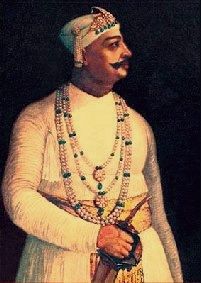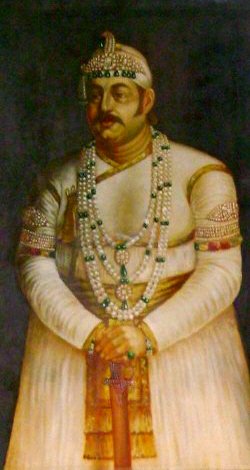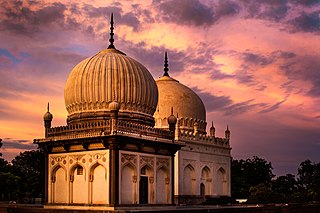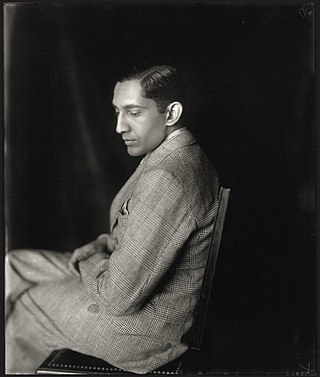Related Research Articles

Hyderabad State was an independent monarchy/princely state located in the south-central Deccan region of Indian Subcontinent with its capital at the city of Hyderabad. It is now divided into the present-day state of Telangana, the Kalyana-Karnataka region of Karnataka, and the Marathwada region of Maharashtra in India.

Asaf Jah VI, also known as Sir Mir Mahboob Ali Khan Siddiqi Bayafandi, was the 6th Nizam of Hyderabad. He ruled Hyderabad State, one of the princely states of India, between 1869 and 1911.

Paigah family was a noble family from the former Hyderabad State. The family maintained their own court, individual palaces, and a standing army of about fourteen thousand infantry and cavalry troops.

Nawab Mir Akbar Ali Khan Siddiqi Bahadur, Sikander Jah, Asaf Jah III, was the 6th Nizam/Ruler of Hyderabad, India from 1803 to 1829. He was born in Chowmahalla Palace in the Khilwath, the second son of Asaf Jah II and Tahniat un-nisa Begum.

Mir Farqunda Ali Khan commonly known as Nasir-ud-Daulah, was Nizam of Hyderabad, a princely state of British India, from 24 May 1829 until his death in 1857.

Afzal ad-Dawlah, Asaf Jah VMir Tahniyat Ali Khan Siddiqi was the ruling Nizam of Hyderabad, India, from 1857 to 1869.

Nizam Mir Barkat Ali Khan Siddiqi Mukarram Jah, Asaf Jah VIII, less formally known as Mukarram Jah, was the titular Nizam of Hyderabad between 1967 and 1971. He was the head of the House of Asaf Jah until he died in 2023 .

The Qutub Shahi Tombs are located in the Ibrahim Bagh, close to the famous Golconda Fort in Hyderabad, India. They contain the tombs and mosques built by the various kings of the Qutub Shahi dynasty. The galleries of the smaller tombs are of a single storey while the larger ones are two storied. In the centre of each tomb is a sarcophagus which overlies the actual burial vault in a crypt below. The domes were originally overlaid with blue and green tiles, of which only a few pieces now remain.

The Asaf Jahi was a Muslim dynasty that ruled the Hyderabad State. The family came to India in the late 17th century and became employees of the Mughal Empire. They were great patrons of Persian culture, language, and literature, and the family found ready patronage.

Banjara Hills is an urban commercial centre and one of the most affluent neighbourhoods in Hyderabad, Telangana, India. This is an upmarket locality close to Jubilee Hills. This area was a hilly forest and was least inhabited in the past. Only few royal members of the Nizam's dynasty lived here, which was a hunting ground for them. Even with its history and status, this area now has completely been transformed to an urban commercial centre consisting of an array of high-end hotels, restaurants, night clubs and office buildings of global corporations. Banjara Hills is segregated by its road numbers, with each road having its own importance: the numbers start from 1 and end at 14.

Sir Viqar ul-Umara, Iqtidar ul-Mulk, Iqbal ud-Dowla, Secundar Jung, Nawab Muhammad Fazl-ud-din Khan Bahadur, was the Prime Minister of Hyderabad from 1893 to 1901, and also served as the Amir e Paigah from 1881 to 1902.

Paigah Tombs or Maqhbara Shams al-Umara, are the tombs belonging to the nobility of Paigah family, who were fierce loyalists of the Nizams, served as statespeople, philanthropists and generals under and alongside them. The Paigah tombs are among the major wonders of Hyderabad State which are known for their architectural excellence as shown in their laid mosaic tiles and craftsmanship work. Since it was Amir-e-Kabir H.E. Nawab Sir Khursheed Jah Bahadur who built the Paigah Tombs, he gave special preference in terms of construction to his immediate family. Of all the arches at Paigah Tombs, it is only the arch of his family's tomb that is bigger when compared with others. the entire necropolis was built earlier then the architecture would have been the same for all the tombs but instead in terms of architectural beauty, the tomb of Nawab Sir Khursheed Jah's family was given special preference. The largest arch and the double maqbara inside known as "Mahajar" cannot be seen inside any other tomb and also to mention the beautifully decorated stucco work in the tomb of Lateefunnisa Begum Saheba is not found in any other tomb. The tombstone of Lateefunnisa Begum Saheba, on which is already mentioned was built by Nawab Sir Khursheed Jah Bahadur. "Lateefunnisa Begum Saheba Jid'de Mohammed Mohiuddin Khan Khursheed Jah Tayyari ye Mohammed Mohiuddin Khan Khursheed Jah Bahadur." The word "Jid'de" over here would mean Grandmother of Sir Khursheed Jah Bahadur and "Tayyari'ye Mohammed Mohiuddin Khan Khursheed Jah Bahadur" would mean "Prepared by Khursheed Jah Bahadur." Inside this tomb are the graves of Nawab Sir Khursheed Jah Bahadur's immediate family members. Shahzadi Hussainunnisa Begum (Wife), Shahzadi Hashmatunnisa Begum (Mother), Amir-e-Kabir Nawab Mohammed Rasheeduddin Khan Bahadur (Father) and Hussaini Begum. The Paigah's necropolis is located in a quiet neighbourhood 4 km southeast of Charminar Hyderabad, at Phisal banda suburb, down a small lane across from Owaisi Hospital near Santosh Nagar. These tombs are made out of lime and mortar with beautiful inlaid marble carvings. These tombs are 200 years old and represent the final resting places of several generations of the Paigah Nobles.

Moazzam Jah, Walashan Shahzada Nawab Mir Sir Shuja’at ‘Ali Khan Siddiqui Bahadur, KCIE, was the son of the last Nizam of Hyderabad, Osman Ali Khan, Asaf Jah VII and his first wife Dulhan Pasha Begum.

Hyderabad is located in central Telangana and is spread over an area of 2,500 km2. The city lies in the Deccan Plateau and rises to an average height of 536 m above the sea level. The city lies at 17.366° N latitude and 78.476° E longitude.

The Old City of Hyderabad is a walled city of Hyderabad, Telangana, India, located on the banks of the Musi River built by Qutb Shahi sultan Muhammed Quli Qutb Shah in 1591 AD. There used to be a wall surrounding the Old City, most of which is destroyed. Mubariz Khan, the Mughal governor of Deccan Subah, had fortified the city in 1712 and was completed by Nizam of Hyderabad.

The culture of Hyderabad, also known as Hyderabadi Tehzeeb or Dakhini Tehzeeb, is the traditional cultural lifestyle of the Hyderabadi Muslims, and characterizes distinct linguistic and cultural traditions of North and South India, which meet and mingle in the city and erstwhile kingdom. This blending was the result of the geographic location of the region and the variety of historical dynasties that ruled the city across different periods—its inception by the Qutub Shahi dynasty in 1591 AD, the occupation by the Mughal Empire and its decline, and the patronage under the Asaf Jahi dynasty.
Hyderabad was the capital of the Indian states of Telangana and Andhra Pradesh. It is a historic city noted for its many monuments, temples, mosques and bazaars. A multitude of influences has shaped the character of the city in the last 400 years.

The Culture of Telangana in India has a cultural history of about 5,000 years. The region emerged as the foremost centre of culture in Indian subcontinent during the rule of Kakatiyas, the Qutb Shahis and Asaf Jahi dynasties—. The rulers patronage and interest for culinary, arts and culture transformed Telangana into a multi-cultural region where two different cultures coexist together, thus making Telangana the representative of the Deccan Plateau and its heritage with Warangal and Hyderabad being its epicenter. Hyderabadi cuisine and Kakatiya architecture both from Telangana, are on the list of UNESCO creative city of gastronomy and UNESCO World Heritage Site. The regions major cultural events celebrated are "Kakatiya Festival" and Deccan Festival along with religious festivals Bonalu, Bathukamma, Dasara, Ugadi, Sankranthi, Milad un Nabi and Ramadan.

A distinct Indo-Islamic architecture style with local contribution is reflected in the historical buildings of Hyderabad, making it the first and "Best Heritage City of India" as of March 2012. The city houses many famous historical sites constructed during Qutb Shahi and Asaf Jahi period, including various mosques and palaces.
References
- ↑ Varmā, Ānand Rāj. Ḥaidarābād, muḥalle, galī, kūce = Hyderabad, mohalle, gali, kooche. New Delhi. ISBN 9788170547389. OCLC 934278764.
- ↑ Ifthekhar, J. S. (13 February 2013). "A rich repertoire of Hyderabadi naamaan". The Hindu. ISSN 0971-751X . Retrieved 21 July 2018.
- ↑ "Of Begums, Mahbubs and Shers: The stories narrated by Hyderabad's neighbourhood names". The News Minute. 8 March 2017. Retrieved 23 November 2018.
- ↑ Ababu Minda Yimene (2004). An African Indian Community in Hyderabad. Göttingen: Cuvillier. ISBN 3-86537-206-6. Archived from the original on 28 September 2013. Retrieved 21 July 2018.
- 1 2 3 4 "Names of city localities hark back to a forgotten era - Times of India". The Times of India. Retrieved 21 July 2018.
- ↑ "The scientist who promoted self-reliance". The Hindu. 19 September 2012. ISSN 0971-751X . Retrieved 5 December 2020.
- 1 2 3 4 5 6 7 8 Imam, Syed (2008). Untold Charminar. Penguin Books. p. 310. ISBN 9780143103707.
- ↑ "The man who gave Hyderabad its 'Banjara Hills', Nawab Mehdi Nawaz Jung". The News Minute. 9 September 2015. Retrieved 21 July 2018.
- 1 2 3 4 5 6 7 8 "A History behind Street Names of Hyderabad & Secunderabad". www.knowap.com. Archived from the original on 19 March 2017. Retrieved 21 July 2018.
- ↑ "Begum Bazaar Hyderabad". www.indianmirror.com. Retrieved 21 July 2018.
- ↑ "Yeh Humara Shehar: Chaderghat". The Hans India. Retrieved 22 July 2018.
- ↑ "Hyderabad: Neglect ails 1st hospital of Asia". Deccan Chronicle. 8 October 2016. Retrieved 21 July 2018.
- ↑ "Photo essay: Hayath Bakshi Begum- The hand of the king, three times over". The News Minute. 23 April 2016. Retrieved 21 July 2018.
- ↑ Wright, Colin. "James Street, Secunderabad". www.bl.uk. Archived from the original on 12 July 2018. Retrieved 21 July 2018.
- ↑ Nanisetti, Serish (19 August 2017). "There lies a forgotten story". The Hindu. ISSN 0971-751X . Retrieved 21 July 2018.
- ↑ Alikhan, Raza (1991). Hyderabad 400 Years, 1591-1991. Zenith Services.
- ↑ "Hyderabad gets India's longest flyover". NDTV.com. Retrieved 21 July 2018.
- ↑ Luther, Narendra (2010). Lashkar: The Story Of Secunderabad (1st ed.). Hyderabad: Kalakriti Art Gallery. ISBN 9788190175210.